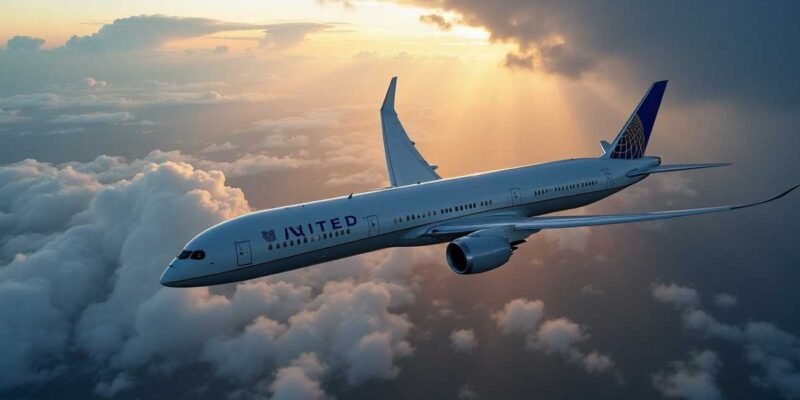A Boeing 787-9 Dreamliner operating United Airlines Flight UA770 from Barcelona to Chicago made an unexpected emergency declaration over Europe. The aircraft N26902 sent out squawk code 7700, which signals a general emergency, as it cruised at altitude.
The pilots decided to head over to London Heathrow Airport at the time of the emergency. Flight UA770 landed safely on Runway 27R around 4:55 PM BST. The aircraft’s unscheduled stop disrupted the flight for more than an hour.
Passengers reported strange noises, sudden cabin pressure changes and a controlled descent. “The crew was calm. That helped a lot. But we didn’t know what was going on,” a passenger recalled. The whole ordeal, from the emergency declaration to the seamless coordination between air traffic control systems, gave an explanation about commercial aviation’s safety protocols.
What triggered the United Airlines Flight UA770 emergency diversion?
A routine transatlantic flight from Barcelona to Chicago on United Airlines Flight UA770 took an unexpected turn about two hours after takeoff. The flight crew had to manage an emergency situation that required quick action.
The moment squawk 7700 was activated
The Boeing 787-9 Dreamliner flew steadily at 37,000 feet over European airspace when the crew made a vital decision. They activated Squawk Code 7700 on the aircraft’s transponder. This universal emergency signal alerted air traffic control centers that the aircraft needed urgent help. The transponder started broadcasting detailed surveillance data, which included exact GPS coordinates and aircraft system status information.
Air traffic control centers in London, Paris, and Madrid picked up the signal immediately. EUROCONTROL’s network tagged the flight for priority handling. The United Airlines operations center in Chicago received up-to-the-minute data about the aircraft’s condition.
Initial signs of trouble mid-flight
The first signs of trouble on UA770 showed through strange noises and a sudden change in cabin pressure. Oxygen masks dropped down, which told passengers the aircraft’s pressurization system had a problem. The crew members pointed to cabin pressurization changes as the likely cause in their early reports.
The flight crew followed standard safety protocols and guided the aircraft to a lower altitude where passengers could breathe normally. The situation raised concerns, but the navigation and propulsion systems worked fine. The crew handled the steep descent professionally and kept it under control.
Why London Heathrow was chosen for diversion
The crew picked London Heathrow Airport for specific reasons. Several key factors influenced this choice: its location along the flight path over Europe, reliable infrastructure, and emergency readiness.
Heathrow had everything needed: long runways, skilled air traffic controllers, and complete on-site emergency services with fire rescue and advanced medical teams. The airport could handle large international flights quickly, which played a significant role in this decision.
Barcelona controllers handed over responsibility to EUROCONTROL after receiving the emergency code. EUROCONTROL worked with British ATC to help the plane descend safely. Modern air traffic management technology proved its worth. These systems cleared a priority path from European airspace to Heathrow’s runway 27R in just 30 minutes.
Inside the aircraft: how the crew and systems responded
The crew and advanced technology aboard United Airlines Flight UA770 worked together seamlessly when an emergency situation developed. Their combined efforts helped manage the crisis.
Boeing 787-9 emergency systems at work
The Boeing 787-9 Dreamliner on Flight UA770 showcases state-of-the-art aviation technology built to handle emergencies. The safety system includes three independent flight control computers that provide backup if one fails. The aircraft’s fly-by-wire system switched to emergency mode automatically. This made the controls simpler for pilots under pressure and stopped dangerous flight positions.
The Airplane Health Management (AHM) system kept track of more than 280,000 measurements from every aircraft system. The system sent live diagnostic data to help the crew make decisions. A network of sensors checked everything from engine performance to hydraulic pressure. This vital information reached both the cockpit and United’s operations center.
Pilot and crew actions during the emergency
The flight crew jumped into action when they spotted the technical problem—which reports linked to cabin pressure changes. The captain turned on Squawk 7700 and worked with air traffic control. They stayed in touch and provided updates about the plane’s condition.
The flight crew looked at nearby airports and picked Heathrow as the best place to land. The cabin crew got the aircraft ready for landing. They secured loose items and made sure passengers stayed in their seats with belts fastened.
Passenger reactions and in-flight experience
Passengers felt confused and worried during the emergency. Many talked about oxygen masks dropping down—a standard step when pressure problems occur. One passenger said, “The masks came down. You think of every flight movie you’ve ever seen”.
Several passengers spoke highly of the United Airlines crew’s professionalism. “The crew was calm. That helped a lot. But we didn’t know what was going on,” another passenger shared. Flight attendants moved quickly through the cabin while they checked on travelers and gave clear instructions. Their actions helped keep everyone relatively calm through the whole ordeal.
Coordinated response on the ground
The crew of United Airlines Flight UA770 declared an emergency, and a well-planned ground response network quickly went into action across several countries.
Air traffic control and emergency landing clearance
The emergency diversion of United Airlines Flight UA770 sparked an impressive display of coordination between international air traffic control systems. The aircraft moved naturally from Spanish to French, and finally to British airspace in just 15 minutes without any delay. EUROCONTROL’s advanced traffic management systems made this quick transition possible. Their conflict resolution algorithms cleared a flight path while weather-integrated route mapping found the safest option.
Control centers passed responsibility smoothly through digital communication channels, radar data fusion, and automated protocols. These technologies helped guide the aircraft to a safe landing on Heathrow’s Runway 27R within 30 minutes of the emergency declaration.
Heathrow’s emergency protocol activation
Heathrow Airport activated its detailed emergency protocols right after receiving the squawk 7700 signal. The airport positioned fire and rescue vehicles along the runway. Medical teams and airport security got ready for the aircraft’s arrival. This quick response followed Heathrow’s Emergency Orders, which spell out specific alerting procedures and starting responsibilities for everyone at the airport.
The airport’s emergency response included:
- Automated emergency detection systems that got fire/rescue teams ready
- Automated gate assignment for quick deboarding
- Live updates to passenger information systems
- Thermal imaging and ARFF vehicles for aircraft inspection
Post-landing inspection and passenger deplaning
Emergency services checked the aircraft right after Flight UA770 landed safely. They looked closely at what caused the pressurization issue and made sure the aircraft was safe.
The crew then let passengers leave the plane in an organized way while emergency teams finished their inspection. United Airlines staff worked with Heathrow’s team to help travelers move through the process. The airlines gave many passengers new travel plans, while others got hotel rooms when their connections were substantially delayed. This team effort kept disruption low and made sure passengers had proper care during this unexpected event.
What we learned from the UA770 emergency diversion today
The United Airlines Flight UA770 emergency diversion today teaches us more than just a successful emergency landing story. It shows us what modern aviation safety systems can do.
The role of technology in modern aviation safety
The Boeing 787-9 Dreamliner in this whole ordeal shows how advanced aviation technology keeps passengers safe. Three independent flight control computers work together to back each other up if one fails. The plane’s sophisticated Airplane Health Management system watches over 280,000 parameters in all aircraft systems. This gives live diagnostic information to crews.
The aircraft started broadcasting enhanced surveillance data the moment squawk 7700 became active. This included exact GPS coordinates and system status information. Modern aircraft like the Dreamliner work just like flying data centers. ADS-B technology tracks the plane live and keeps constant communication between the aircraft and ground control.
How airlines prepare for mid-air emergencies
Airlines put significant resources into emergency preparedness. The core team goes through intense training that focuses on crisis management and communication. The UA770 incident showed how this training turned into quick action.
Quick response came from 15-year old protocols that kicked in when the emergency started. The aviation industry’s resilience shines through its well-trained staff and advanced technologies during tough situations. Everyone from cockpit to ground operations knew exactly what to do thanks to detailed backup plans.
Implications for future transatlantic flights
Every emergency diversion adds valuable data to aviation safety systems. A complete analysis of incidents like UA770 helps the industry make safety protocols better. This could prevent similar emergencies by spotting risk factors early.
The technology that helped during this emergency will keep getting better, which points to more advanced emergency response capabilities. Airlines now use AI-driven predictive maintenance systems. These systems look at data from sensors in aircraft parts to find problems before they become serious. This makes long-haul routes more reliable.
Conclusion
Modern aviation’s multi-layered safety systems proved their worth during United Airlines Flight UA770’s emergency. The combination of advanced technology and human expertise stopped a serious situation from getting worse. The flight crew showed their extensive training and professionalism as they took decisive action to handle cabin pressurization problems.
The complex aviation networks showed their strength under pressure through uninterrupted coordination between international air traffic control centers. The emergency showed why backup systems matter – from the Boeing 787-9’s triple computer setup to protocols that help planes move smoothly between different airspaces.
Passenger safety remained the main goal throughout the whole ordeal. Though passengers felt scared, the controlled emergency response kept panic at bay and protected everyone’s safety. United Airlines’ emergency preparedness shone through the calm, systematic actions of both flight attendants and pilots.
This single incident expresses how modern commercial aviation strikes a balance between cutting-edge technology and practical safety measures. Every emergency landing provides crucial data that makes future flight protocols stronger. The aviation industry learns from these experiences, so it knows how to handle unexpected situations better.
Commercial aviation’s layered safety approach works well, even though emergencies create anxious moments. Passengers can feel secure knowing that each flight has a vast network of professionals and technologies working to ensure their safe arrival, even when challenges pop up unexpectedly.












